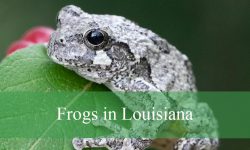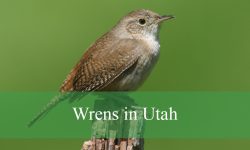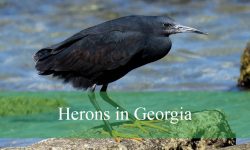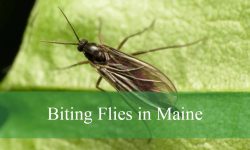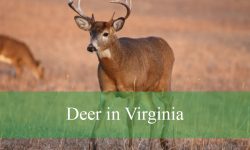Standing in a quiet Georgia backyard or wandering through lush woodlands, the flashes of red from birds immediately catch your eye. From the familiar Northern Cardinal singing atop a flowering shrub to the striking Scarlet Tanager hidden high in the forest canopy, Georgia offers a dazzling array of red-feathered birds. Each species brings its own unique colors, calls, and behaviors, making every sighting a small adventure for birdwatchers.
Exploring suburban parks, wetlands, or forest edges reveals these 15 red birds in all their vibrant glory. Learning to identify them by plumage, song, and habitat adds depth to every outdoor experience, showcasing the rich diversity of Georgia’s avian life.
Common Red Birds Found in Georgia
Northern Cardinal (Cardinalis cardinalis)
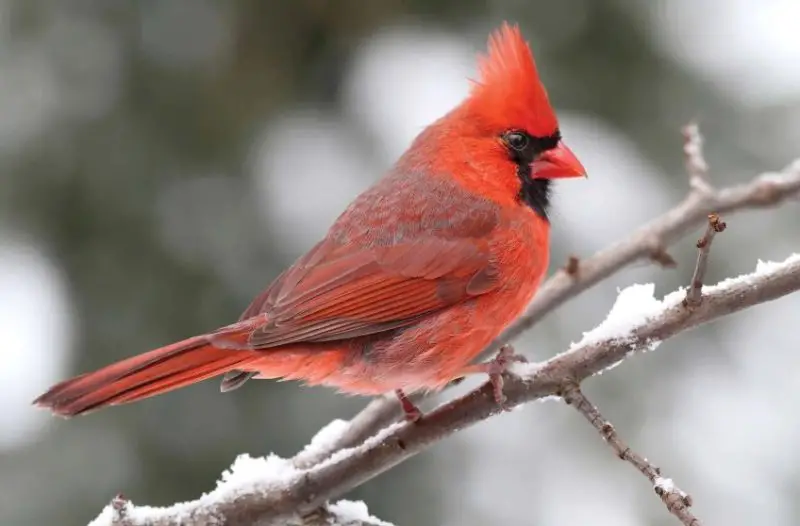
The Northern Cardinal is one of Georgia’s most iconic red birds, instantly recognizable for its vivid red plumage and distinctive crest on the male’s head. Females are more subdued, with warm tan and reddish tinges on the wings and tail. Both sexes feature a bright orange-red beak, which contrasts beautifully against their feathers.
Adult Northern Cardinals are medium-sized songbirds, measuring about 8–9 inches in length with a wingspan of 10–12 inches. They weigh roughly 1.5–1.7 ounces. Males are usually brighter than females, which helps them stand out during mating displays. Their strong, cone-shaped bill is perfectly adapted for cracking seeds, a staple of their diet.
Behaviorally, Northern Cardinals are known for their melodic whistles, often singing throughout the day, especially in spring. They are territorial birds, with males aggressively defending their territory against intruders. Cardinals often forage on the ground or in shrubs, sometimes in pairs or small family groups.
In Georgia, Northern Cardinals are common in backyards, woodlands, and shrublands. They thrive in suburban areas with dense shrubbery for nesting and ample bird feeders for supplemental feeding. These birds are year-round residents, bringing vibrant color to gardens and parks throughout all seasons.
Summer Tanager (Piranga rubra)
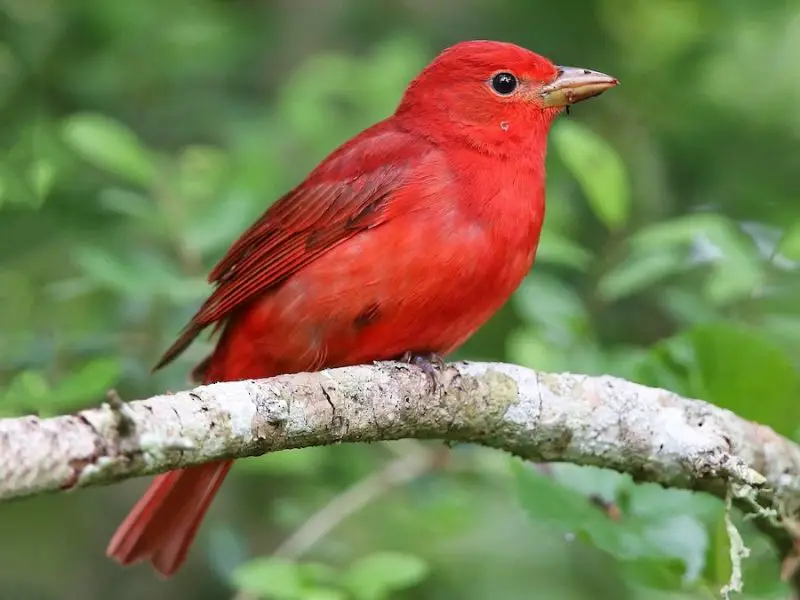
The Summer Tanager is a striking red bird, with adult males completely scarlet, while females exhibit a yellowish-olive coloration. Males are easy to spot during the breeding season because of their uniform, bright red plumage, which covers the head, body, and wings. Their conical beak is pale and strong, ideal for catching insects and consuming fruit.
Adult Summer Tanagers are medium-sized, about 7.5–8.7 inches long, with a wingspan of 12 inches. They weigh between 1.1–1.4 ounces. Their slim, elegant bodies allow them to maneuver easily through dense foliage while hunting for insects such as bees and wasps.
These birds are primarily insectivorous during the breeding season, often catching flying insects in midair or picking them off leaves. Summer Tanagers are known for their habit of removing stingers from bees before eating them. They are usually solitary or found in pairs, rarely forming large flocks.
In Georgia, Summer Tanagers prefer open woodlands, riparian forests, and areas with scattered trees. They breed throughout the state in spring and summer and migrate to Central and South America for the winter. Their vibrant red color makes them stand out in the dense green canopy during the warmer months.
Scarlet Tanager (Piranga olivacea)
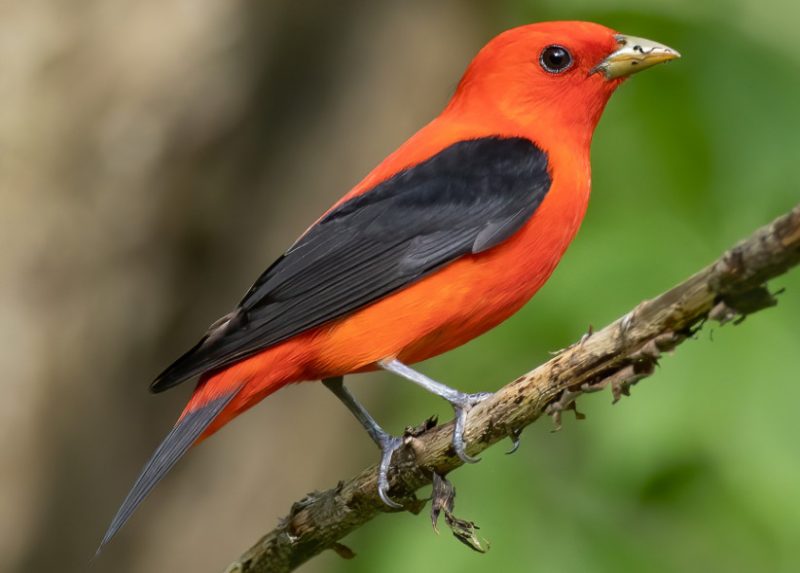
Scarlet Tanagers are among the most vividly colored birds in Georgia. Adult males are brilliant red with contrasting jet-black wings and tail, while females are yellowish-green, blending seamlessly into leafy canopies. Their short, thick bill is well-suited for catching insects, which comprise most of their diet during summer.
These birds are medium-sized songbirds, measuring 7–8 inches in length with a wingspan of about 11–13 inches and weighing around 1–1.2 ounces. Their size and coloration make males particularly noticeable during the breeding season, especially when perched in treetops.
Scarlet Tanagers are primarily arboreal and often remain high in the canopy. They feed on insects, spiders, and some fruits, using a combination of gleaning and hawking techniques. Their song is a distinctive, burry “chick-burr” that resonates through forests during the spring and summer months.
In Georgia, Scarlet Tanagers inhabit mature deciduous forests and wooded areas, often favoring areas with large tracts of trees. They are migratory, arriving in late April and departing by September. Birdwatchers often spot them in state parks and forest preserves, where their brilliant red plumage contrasts with the greenery.
House Finch (male) (Haemorhous mexicanus)
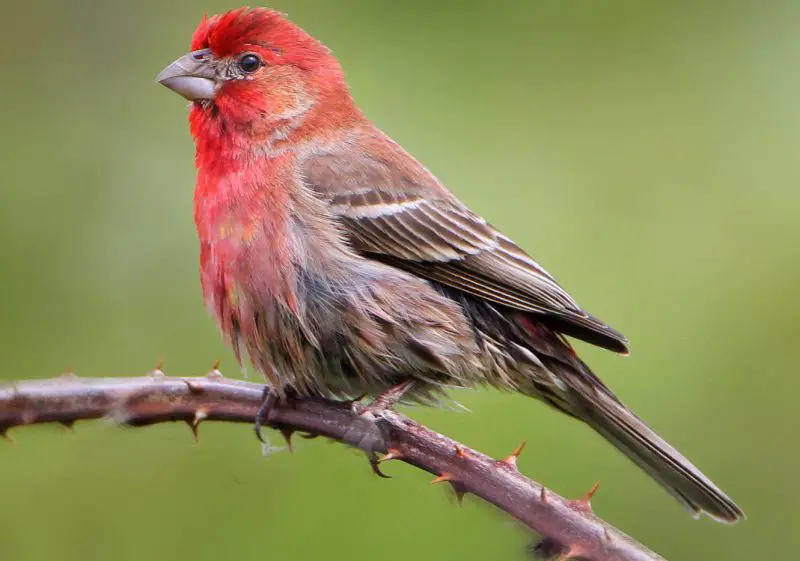
Male House Finches are small birds with rosy red coloration on the head, throat, and chest, while females are streaked brown and gray. The red intensity can vary among males depending on diet and region, but in Georgia, the crimson hue is generally bright and eye-catching. They have a short, conical beak, perfect for seed consumption.
House Finches measure about 5–6 inches in length, with a wingspan of 8–10 inches and a weight of 0.6–1 ounce. Their small, stocky bodies allow them to navigate easily through urban areas and backyards. Their flight is undulating, and they often move in small flocks outside the breeding season.
These birds are highly social and gregarious, frequently visiting feeders and urban gardens. Their diet primarily consists of seeds, berries, and fruits, though they occasionally consume small insects. Males sing cheerful warbling songs to attract mates and establish territories.
House Finches are extremely adaptable in Georgia, thriving in urban and suburban areas, farmlands, and forest edges. They nest in trees, shrubs, and even on building ledges. Their ability to coexist closely with humans has made them one of the most common red-colored birds in the state.
Red-headed Woodpecker (Melanerpes erythrocephalus)
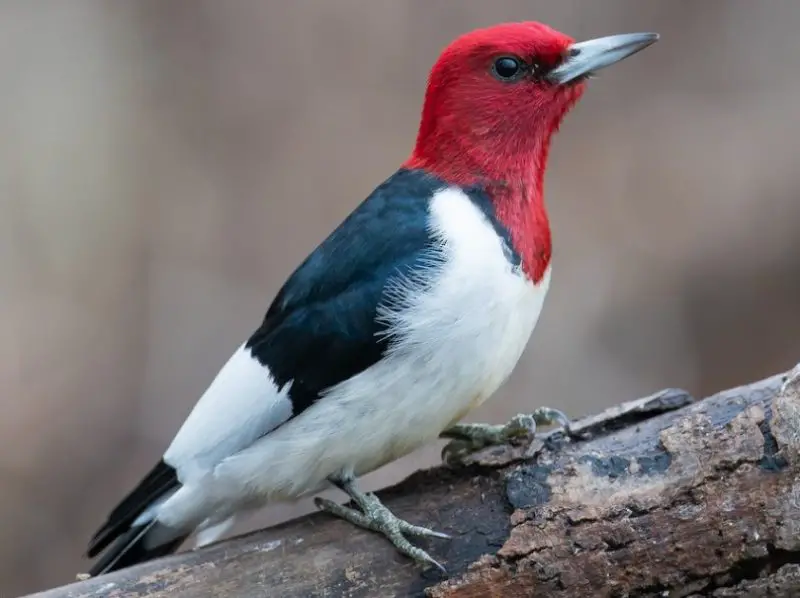
The Red-headed Woodpecker is instantly recognizable due to its completely crimson head, contrasted with a white body and black wings. Juveniles and females often have slightly duller red coloration, but adults are strikingly vibrant. Its stout, chisel-like bill allows it to drill into wood to find insects or create nesting cavities.
This medium-sized woodpecker measures 7.5–9 inches in length with a wingspan of 16–18 inches and weighs 2.5–3.5 ounces. Their strong build and powerful bill enable them to cling vertically to trees while foraging. They are known for their bold, direct flight, characterized by stiff, rapid wingbeats.
Red-headed Woodpeckers are omnivorous, feeding on insects, fruits, seeds, and occasionally small vertebrates. They are known to cache food in tree crevices for later consumption, displaying remarkable memory and resourcefulness. These woodpeckers are often aggressive toward other birds at feeding sites.
In Georgia, Red-headed Woodpeckers prefer open woodlands, forest edges, and areas with scattered trees or dead snags for nesting. They are year-round residents in some regions but may shift locally depending on food availability. Their brilliant red head and energetic behavior make them a favorite among birdwatchers.
Vermilion Flycatcher (Pyrocephalus rubinus)
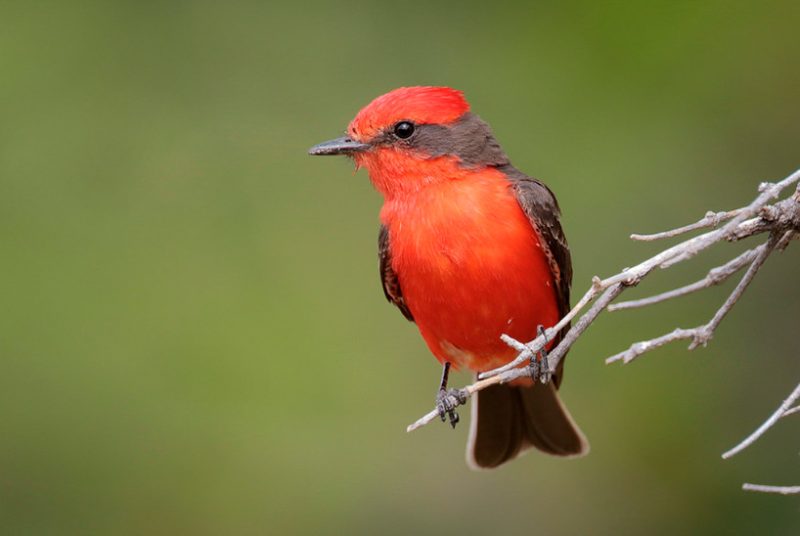
The male Vermilion Flycatcher is a vivid, flame-red bird with dark brown wings and tail, making it a striking sight against open landscapes. Females are more subdued, with pale yellow underparts and grayish-brown wings. Their broad, flat bills are perfectly adapted for catching insects in midair.
Adult Vermilion Flycatchers are small, measuring about 5–5.5 inches in length with a wingspan of 8–9 inches and weighing roughly 0.4–0.6 ounces. Their compact body and strong wings allow agile flight, which is essential for aerial hunting. Males display bright plumage during the breeding season to attract mates and defend territories.
Behaviorally, they are highly active hunters, often perching conspicuously on branches or fences before sallying out to catch flying insects. Their diet mainly consists of flying insects, though they may occasionally consume berries. They are territorial during the breeding season, with males performing aerial displays to ward off rivals.
In Georgia, Vermilion Flycatchers are rare but can occasionally be spotted in open fields, farmlands, and areas near rivers. They prefer areas with scattered trees and shrubs for perching while hunting. Their brilliant red coloration and acrobatic flight make them a favorite among birdwatchers when sighted.
Red-bellied Woodpecker (Melanerpes carolinus)
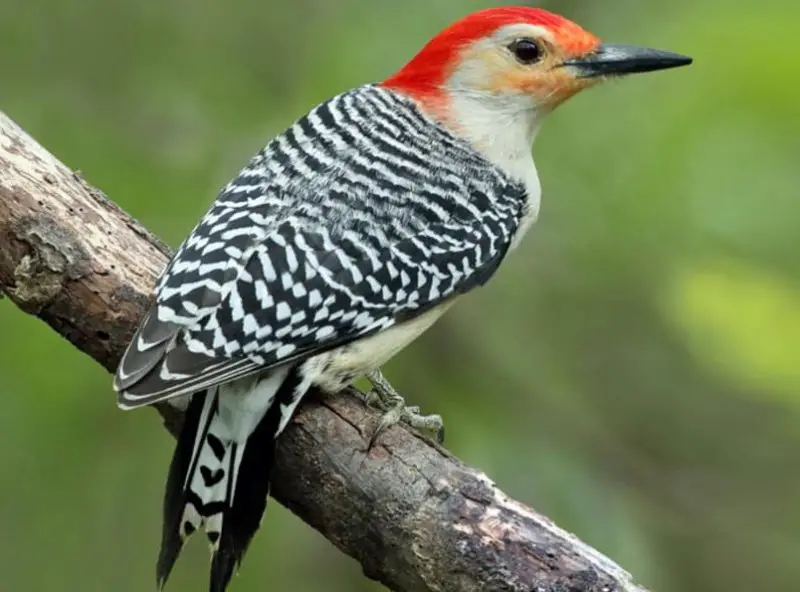
The Red-bellied Woodpecker is easily identified by its pale belly, bold black-and-white barred back, and bright red cap extending from the bill to the nape in males. Females have a smaller red patch, limited to the back of the head. Despite the name, the red on the belly is often faint and less noticeable than the striking head and back patterns.
This medium-sized woodpecker measures about 9–10 inches long with a wingspan of 13–16 inches and weighs around 2.5–3 ounces. Its sturdy build and sharp bill allow it to cling to tree trunks and excavate wood for insects or nesting cavities. Its undulating flight pattern is distinctive, characterized by a series of rapid wingbeats followed by a glide.
Red-bellied Woodpeckers are omnivorous, feeding on insects, nuts, seeds, and fruits. They are known to store food in tree crevices, demonstrating remarkable memory. They are vocal birds, producing loud calls and drumming on tree trunks to communicate and defend territory.
In Georgia, Red-bellied Woodpeckers are common in forests, suburban yards, and wooded parks. They are year-round residents, adapting well to human-altered landscapes. Their striking red head and black-and-white patterned back make them easy to identify, even at a distance.
Pine Grosbeak (Pinicola enucleator)
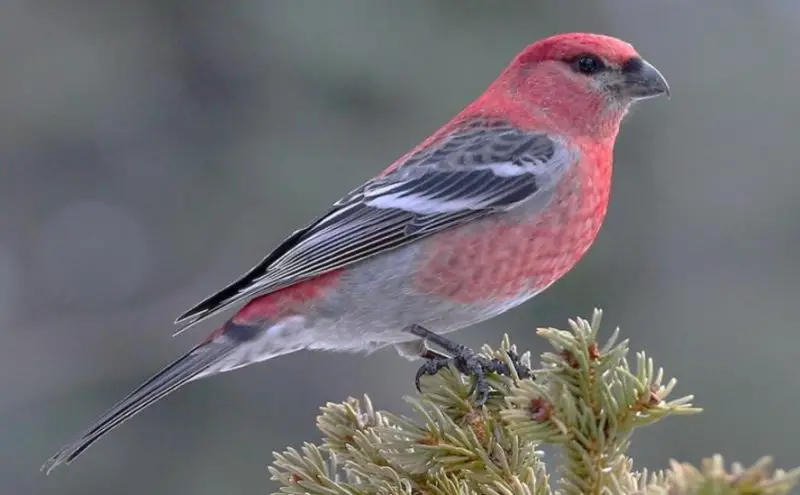
The Pine Grosbeak is a large, plump finch with a soft, rosy-red color on males, especially on the head, breast, and back, while females are grayish with yellowish tones. Its heavy, conical bill is ideal for cracking seeds and eating buds during winter months. This species is rare in Georgia, typically seen during winter irruptions from the north.
Adults measure about 7.5–9 inches in length with a wingspan of 12–14 inches and weigh 1.5–2 ounces. Their robust body and short tail give them a solid, approachable appearance. They are not particularly agile in flight but are strong fliers over short distances when moving between trees.
Pine Grosbeaks are social birds, often seen in flocks during winter. They feed mainly on seeds, buds, berries, and some insects. Their gentle behavior contrasts with other finches, as they are relatively tame and often allow close observation from feeders or nearby trees.
In Georgia, Pine Grosbeaks are rare visitors, usually spotted in northern parts of the state during harsh winters when food is scarce in their normal northern ranges. Birdwatchers value these sightings highly due to their bright red coloration and uncommon presence.
Purple Finch (male) (Haemorhous purpureus)
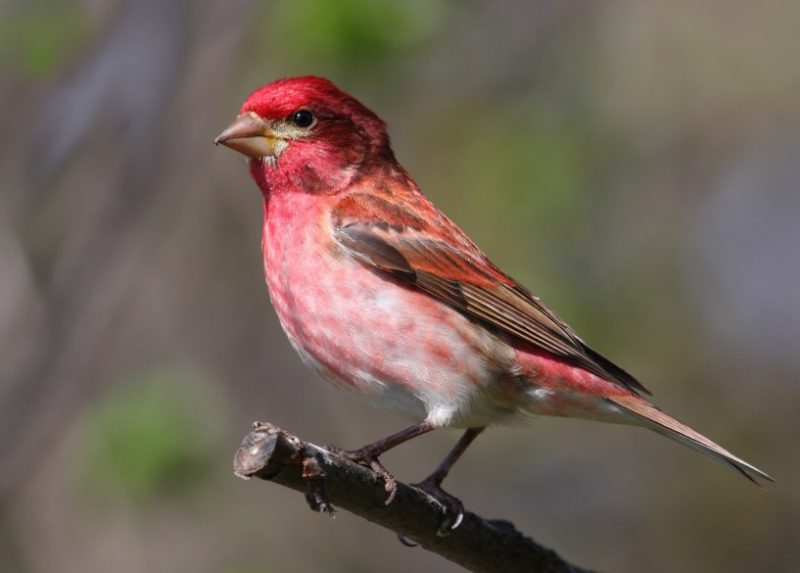
Male Purple Finches exhibit a rich raspberry-red coloration covering the head, chest, and back, while females are streaked brown with subtle hints of red. They are smaller than grosbeaks but larger than House Finches, with a slightly longer, notched tail and strong, conical bill adapted for seed eating.
Purple Finches measure about 5.5–6.5 inches in length, with a wingspan of 8–10 inches and weighing approximately 0.7–1 ounce. Their relatively slender bodies allow them to navigate shrubs and trees efficiently while foraging. Males’ bright plumage helps them attract females during the breeding season.
These birds primarily feed on seeds, buds, and berries, occasionally taking insects in spring. They are energetic foragers, often moving through trees and shrubs in small flocks. Males sing sweet, warbling songs to advertise territory and attract mates, while females are quieter.
In Georgia, Purple Finches are commonly found in mixed forests, woodland edges, and suburban areas with abundant trees. They are more frequently seen during migration or winter months, with northern populations moving south to find food. Their vivid red coloration makes males stand out even in dense foliage.
American Robin (Turdus migratorius)
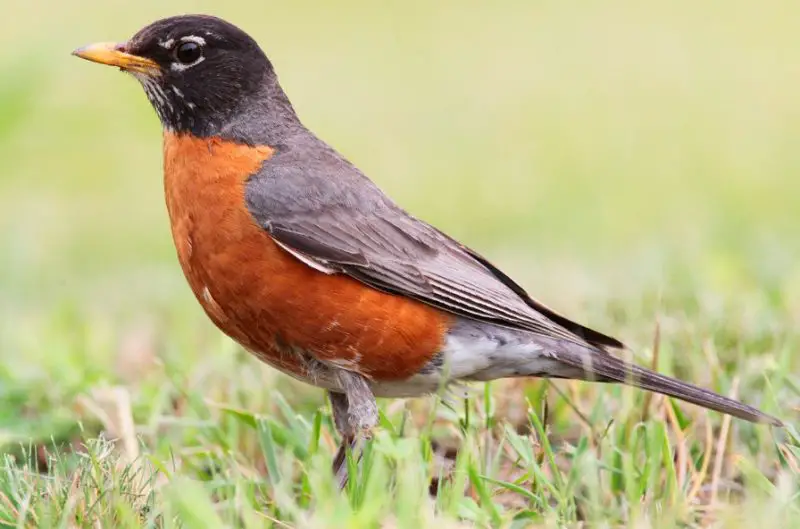
The American Robin is easily recognizable by its reddish-orange breast, gray-brown back, and yellow beak. Both sexes display this coloration, although males are slightly brighter. Its round body and long legs give it a distinctive upright posture while walking on lawns or perching on tree branches.
Robins measure 9–11 inches in length, with a wingspan of 12–16 inches and a weight of 2.5–3 ounces. They are strong, agile fliers and often migrate in large flocks during fall and spring. Their size and coloration make them one of the most easily recognized red-breasted birds in Georgia.
American Robins are omnivorous, feeding on earthworms, insects, and a variety of fruits. They are active foragers, often seen hopping on lawns in search of worms or picking berries from shrubs and trees. Their melodious song and cheerful calls are commonly heard in residential areas.
In Georgia, robins are abundant year-round, though northern populations migrate south for winter. They inhabit forests, backyards, parks, and suburban areas, adapting well to human environments. Their bright orange breast provides a vivid splash of color in spring and winter landscapes alike.
Rose-breasted Grosbeak (Pheucticus ludovicianus)
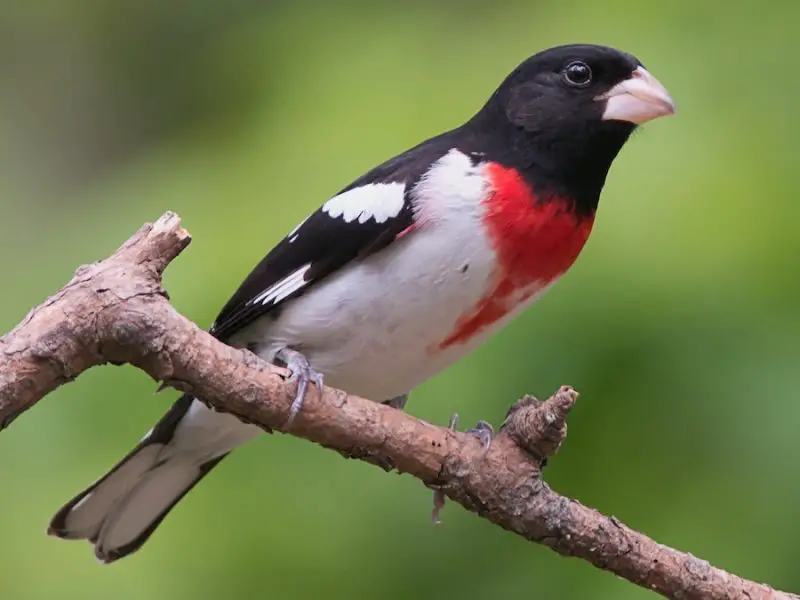
The male Rose-breasted Grosbeak is striking with a black head, back, and wings contrasted by a brilliant rose-red patch on the breast. Females are brown with streaked underparts and a subtle white eyebrow stripe. Both sexes have a thick, conical bill adapted for cracking seeds and consuming fruits.
Adults measure about 7.5–9 inches in length, with a wingspan of 11–14 inches and weigh roughly 1.5–2 ounces. Their medium size and strong beak make them efficient foragers, while their robust body allows agile movements through trees and shrubs. Males’ bright red chest is most vivid during the breeding season, making them easy to identify.
Rose-breasted Grosbeaks feed primarily on insects, seeds, and berries. They are known for their melodious, flute-like songs, which males use to establish territory and attract females. These birds are generally solitary or found in pairs during breeding, forming loose flocks during migration.
In Georgia, Rose-breasted Grosbeaks are migratory visitors, arriving in spring to breed and departing by fall. They favor deciduous forests, woodland edges, and suburban areas with large trees. Birdwatchers often spot them in parks and backyards where fruiting trees are present.
Red Crossbill (Loxia curvirostra)
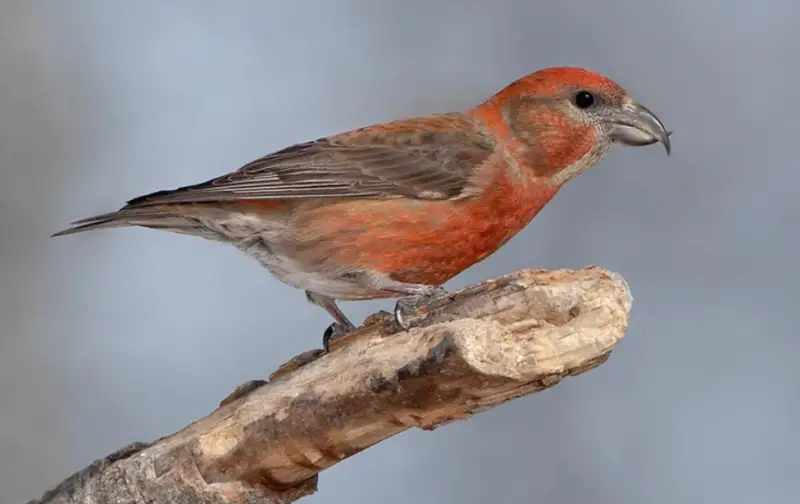
The male Red Crossbill is bright red with darker wings and a distinctive crossed bill, which is perfectly adapted for extracting seeds from conifer cones. Females are olive-yellow with similar wing patterns. Their unusual bill shape is the most distinctive field mark, allowing them to exploit a food source many other birds cannot.
Adult Red Crossbills measure 5–7 inches long, with a wingspan of 8–11 inches and weigh around 1 ounce. Their robust, stocky bodies and short tails aid in maneuvering among conifers, while their strong feet help them cling to branches while prying open cones.
These birds are highly specialized feeders, primarily consuming conifer seeds, though they occasionally eat berries or small insects. Red Crossbills are nomadic, moving in response to cone availability rather than following strict migratory patterns. They are social birds, often traveling in flocks and communicating with high-pitched, musical calls.
In Georgia, Red Crossbills are uncommon and mostly found in pine forests, particularly in northern and mountainous regions. Sightings are more frequent during irruption years when northern food sources fail. Their bright red color and crossed bill make them unmistakable for bird enthusiasts.
Common Redpoll (Acanthis flammea)
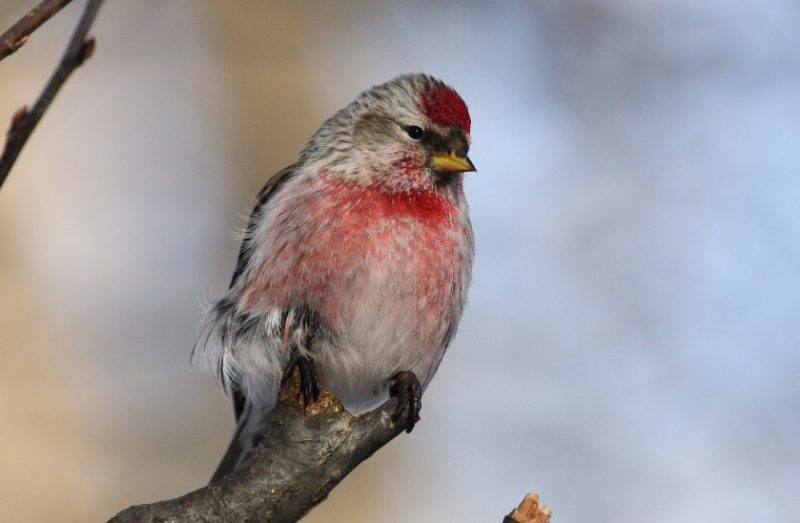
The Common Redpoll is a small finch with a rosy-red forehead and subtle streaks of red on the breast. Females are paler with brown streaking, while males display a more pronounced red wash. They have a small, conical bill well-suited for consuming tiny seeds, especially from birch and alder trees.
Adults measure about 4.5–5.5 inches long, with a wingspan of 7.5–8.5 inches and weigh roughly 0.4–0.6 ounces. Their compact bodies and short tails make them agile in flight, often seen flitting energetically among tree branches and shrubs.
Common Redpolls feed mainly on seeds, particularly birch and alder seeds, but they also consume small insects during the breeding season. They are highly social birds, forming large flocks in winter that can include hundreds of individuals. Their quick movements and constant foraging make them fun to observe.
In Georgia, Common Redpolls are rare winter visitors, usually appearing in northern areas when northern populations move south. Their small size, bright red forehead, and streaked body help birdwatchers identify them among flocks of other finches.
Red-winged Blackbird (male) (Agelaius phoeniceus)
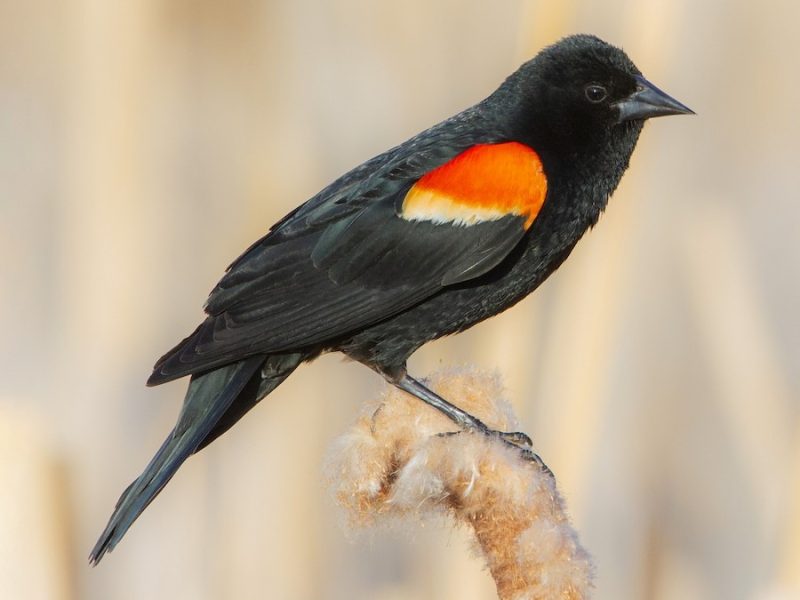
Male Red-winged Blackbirds are instantly recognizable by their glossy black body and striking red shoulder patches, or epaulets, edged with yellow. Females are brown and heavily streaked, often blending into marsh vegetation. Both sexes have sharp, pointed bills ideal for consuming seeds and insects.
These medium-sized blackbirds measure 7–9 inches in length, with a wingspan of 12–16 inches and weigh around 2.5–3 ounces. Males are slightly larger than females and are highly territorial, often perched prominently on cattails or fence posts. Their loud, distinctive calls are heard throughout marshes and fields.
Red-winged Blackbirds feed on seeds, grains, and insects, with diet varying seasonally. During breeding season, males aggressively defend territories to attract females and protect nesting areas. They are social birds outside the breeding season, often forming large flocks with other blackbirds and starlings.
In Georgia, Red-winged Blackbirds are abundant in wetlands, marshes, agricultural fields, and along rivers. Their bright red shoulder patches make males easy to spot, especially during the spring and summer when defending territories and courting mates.
Painted Bunting (male) (Passerina ciris)
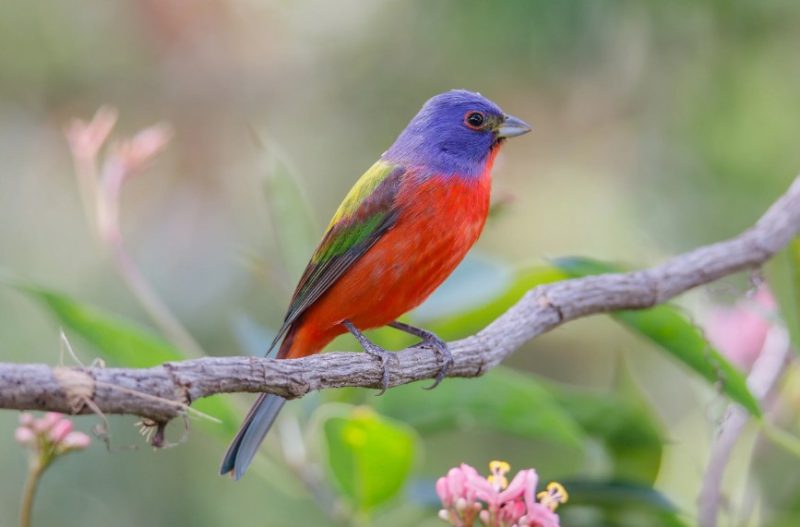
Male Painted Buntings are among the most colorful birds in Georgia, with a combination of red, blue, and green plumage. Their vivid red underparts contrast with blue heads and green backs. Females are greenish-yellow, providing excellent camouflage. Both sexes have short, conical bills suited for seed consumption.
Adults measure about 4–5 inches long, with a wingspan of 9–10 inches and weigh approximately 0.6–0.8 ounces. Their small, compact bodies and strong wings allow for agile flight through shrubs and open woodland edges. Males are highly conspicuous during the breeding season due to their dazzling colors.
Painted Buntings primarily feed on seeds and small insects, often foraging on the ground or in low vegetation. Males sing melodic, complex songs to establish territories and attract mates. They are generally shy outside the breeding season, making sightings a special treat for birdwatchers.
In Georgia, Painted Buntings inhabit shrubby areas, woodland edges, and backyards with dense vegetation. They are migratory, arriving in late spring to breed and leaving by early fall. Their extraordinary color palette makes them one of the most sought-after birds for observation and photography.
FAQs About Red Birds in Georgia
What are the most common red birds in Georgia?
The most common red birds in Georgia include the Northern Cardinal, Summer Tanager, Scarlet Tanager, House Finch (male), and Red-bellied Woodpecker. These species are frequently seen in backyards, forests, and suburban areas throughout the year or during migration seasons.
How can I identify a Northern Cardinal?
Northern Cardinals are easy to identify due to the male’s bright red plumage, distinctive crest, and orange-red beak. Females are more subdued, with tan or brown bodies and reddish tinges on the wings and tail. Cardinals are medium-sized birds and often sing melodious whistles from perches.
When can I see Scarlet Tanagers in Georgia?
Scarlet Tanagers are migratory birds that visit Georgia during spring and summer. Males are bright red with black wings and tails, while females are yellowish-green. They prefer mature deciduous forests and are often found high in the canopy, making them more challenging to spot.
Are Red-headed Woodpeckers year-round residents in Georgia?
Yes, Red-headed Woodpeckers can be found year-round in Georgia, although local populations may shift depending on food availability. They favor open woodlands, forest edges, and areas with scattered trees or dead snags for nesting.
What do Summer Tanagers eat?
Summer Tanagers primarily feed on insects, including bees and wasps, which they remove stingers from before eating. They also consume fruits, especially during migration. They hunt by perching quietly before catching insects in midair or gleaning them from leaves.
Where can I see Painted Buntings in Georgia?
Painted Buntings are usually found in shrubby areas, woodland edges, and backyards with dense vegetation. They are migratory and appear in Georgia from late spring to early fall during their breeding season. Males are highly colorful with red, blue, and green plumage.
Are Red-winged Blackbirds easy to spot?
Yes, male Red-winged Blackbirds are easy to spot due to their glossy black bodies and bright red shoulder patches. They inhabit wetlands, marshes, riversides, and agricultural fields, often perching conspicuously while defending territories during the breeding season.
How do I attract red birds to my backyard?
You can attract red birds by planting native fruiting shrubs, providing sunflower or nyjer seeds, and offering fresh water sources. Species like Northern Cardinals, House Finches, and Rose-breasted Grosbeaks are frequent visitors to well-stocked feeders and gardens with dense cover for nesting.

